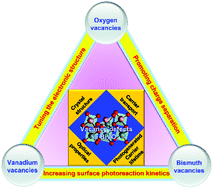Vacancy defect engineering of BiVO4 photoanodes for photoelectrochemical water splitting
Abstract
Photoelectrochemical (PEC) water splitting has been regarded as a promising technology for sustainable hydrogen production. The development of efficient photoelectrode materials is the key to improve the solar-to-hydrogen (STH) conversion efficiency towards practical application. Bismuth vanadate (BiVO4) is one of the most promising photoanode materials with the advantages of visible light absorption, good chemical stability, nontoxic feature, and low cost. However, the PEC performance of BiVO4 photoanodes is limited by the relatively short hole diffusion length and poor electron transport properties. The recent rapid development of vacancy defect engineering has significantly improved the PEC performance of BiVO4. In this review article, the fundamental properties of BiVO4 are presented, followed by an overview of the methods for creating different kinds of vacancy defects in BiVO4 photoanodes. Then, the roles of vacancy defects in tuning the electronic structure, promoting charge separation, and increasing surface photoreaction kinetics of BiVO4 photoanodes are critically discussed. Finally, the major challenges and some encouraging perspectives for future research on vacancy defect engineering of BiVO4 photoanodes are presented, providing guidelines for the design of efficient BiVO4 photoanodes for solar fuel production.

- This article is part of the themed collections: Nanoscale 2022 Emerging Investigators and Recent Review Articles


 Please wait while we load your content...
Please wait while we load your content...